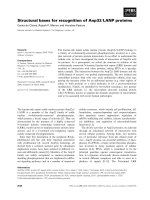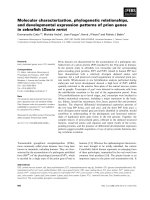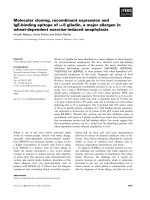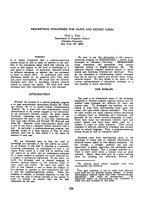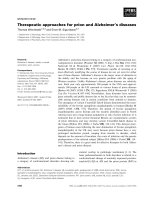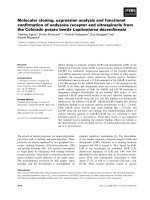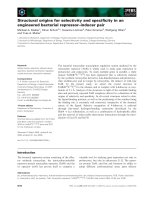báo cáo khoa học: "Note Selection for increased and decreased total number of young born in the first three parities in mice" doc
Bạn đang xem bản rút gọn của tài liệu. Xem và tải ngay bản đầy đủ của tài liệu tại đây (367.79 KB, 8 trang )
Note
Selection
for
increased
and
decreased
total
number
of
young
born
in
the
first
three
parities
in
mice
Yolanda BAYON
L.F. FUENTE
F.
SAN
PRIMITIVO
Departamento
de
Produccion
Animal,
Universidad
de
Leon, Leon,
Spain
Summary
A
selection
experiment
carried
out
in
mice
for
increased
(L’)
and
decreased
(L-)
total
number
of
young
born
alive
in
the
first
three
parities
(TNY-3)
had
been
started
in
our
laboratory.
Data
from
the
first
8
generations
(reported
by
FusN!
&
S
AN
P
RIMI
TIVO
,
1985)
showed
considera-
ble
responses
for
upward
and
downward
selection.
In
the
present
article,
results
obtained
for
generations
9-13
are
described.
Realized
heritability
in
the
L’
line
showed
a
gradual
decline
through
generations,
the
value
obtained
for
generations
9-13
(0.16 ±
0.04)
being
considerably
lower
than
that
estimated
in
the
first
8
generations
by
F
UENTE
&
S
AN
P
RIMITIVO
(1985)
(0.24
±
0.03).
No
response
was
detected
in
the
L-
line
in
this
second
period
and
a
reversion
towards
the
control
line
mean
(C)
occurred.
After
13
generations
of
selection,
cumulated
response,
measured
as a
deviation
from
the
control
line,
was
5.09
young
in
L+
and -
2.11
young
in
L
Means
for
1st,
2nd
and
3rd
litter
size
in
generation
13
were
11.89,
11.11
and
11.63
young
in
L+,
11.03,
10.42
and
9.24
young
in
C
and
10.08,
8.87
and
9.06
young
in
L-,
respectively.
Means
for
6-
week
body
weight
in
generation
13
were
32.57
g,
32.38
g
and
29.44
g
in
L+,
C
and
L-,
respectively.
Key
words :
mice,
litter
size,
selection.
Résumé
Sélection
divergente
sur
le
nombre
total
de
jeunes
nés
dans
les
trois
premières
portées
chez
la
souris
Une
expérience
de
sélection
a
été
conduite
sur
des
souris
dans
notre
laboratoire
afin
d’augmenter
(dans
la
lignée
L+)
et
de
diminuer
(dans
la
lignée
L-)
le
nombre
total
de
jeunes
nés
vivants
dans
les
trois
premières
portées
(TNY-3).
Les
observations
faites
sur
les
huit
premières
générations
(décrites
par
F
UENTE
&
S
AN
P
RIMITIV
O,
1985)
mettaient
en
évidence
d’importantes
réponses
à
la
sélection
dans
les
deux
lignées.
L’objet
du
présent
article
est
de
décrire
les
résultats
obtenus
sur
les
générations
9
à
13.
L’héritabilité
réalisée
dans
la
lignée
L’
a
graduellement
diminué
au
cours
des
générations,
la
valeur
obtenue
dans
les
générations
9 à 13
(0,16
±
0,04)
étant
considérablement
inférieure
à
celle
estimée
dans
les
huit
premières
générations
par
F
UENTE
&
S
AN
P
RIMITIVO
(1985)
(0,24
±
0,03).
Aucune
réponse
n’a
été
détectée
dans
la
lignée
L-
au
cours
de
cette
seconde
période
et
un
retour
vers
la
moyenne
de
la
lignée
témoin
(C)
a
été
observé.
Après
13
générations
de
sélection,
la
réponse
cumulée,
mesurée
par
la
déviation
par
rapport
à
la
lignée
témoin,
était
de
5,09
jeunes
dans
la
lignée
L+
et
de —
2,11
jeunes
dans
la
lignée
L
Dans
la
13’
génération,
les
tailles
moyennes
des
premières,
deuxièmes
et
troisièmes
portées
étaient
respectivement
de
11,89 ; 11,11 ;
11,63
dans
la
lignée
L+,
11,03 ;
10,42
et
9,24
dans
la
lignée
C et
10,08 ;
8,87
et
9,06
dans
la
lignée
L
Dans
cette
génération,
le
poids
moyen
à
six
semaines
était
respectivement
de
32,57
g,
32,38
g
et
29,44
g
dans
les
lignées
L ,
C
et
L
Mots
clés :
souris,
taille
de
portée,
sélection.
I.
Introduction
Despite
the
low
heritability
estimates,
selection
for
first
litter
size in
mice
has
generally
led
to
considerable
response,
partly
due
to
its
high
phenotypic
variation
(FALCONER,
1960 ;
BRADFORD,
1968 ;
,TOAKIMSEN
&
BAKER,
197! ;
EISEN,
1978 ;
B
AK
KER
et
al.,
1978).
A
selection
experiment
based
on
the
total
number
of
young
born
in
the
first
three
litters
(TNY-3)
had
been
started
in
our
laboratory
and
results
from
the
first
8
generations
(F
UENTE
&
S
AN
PR
tMrrtvo,
1985)
had
shown
considerable
responses
for
upward
and
downward
selection.
Responses
obtained
for
generations
9-13
are
reported
in
the
present
paper.
Correlated
responses
in
reproduction
and
growth
traits
are
also
described.
II.
Materials
and
methods
Three
lines
had
been
derived
from
a
randombred
population
of
mice.
Two
of
these
were
divergently
selected
for
large
(L
+)
and
small
(L-)
reproduction
rate,
the
selection
criterion
being
the
total
number
of
young
born
alive
in
the
first
three
parities
(TNY-3).
The
third
line
(C)
served
as
an
unselected
control.
Selection
was
carried
out
over
13
generations
on
the
basis
of
individual
performance
for
females
only
(litter
size
was
considered
a
trait
of
the
dam),
males
being
randomly
chosen.
Breeding
procedures
and
estimating
of
genetic
parameters
have
been
described
by
F
UENTE
&
S
AN
PRIMrrIVO
(1985).
III.
Results
Divergence
between
lines
L’
and
L-
did
not
increase
through
generations
9-13
by
contrast
to
results
obtained
for
generations
1-8
(F
UENTE
&
S
AN
P
RIMITIVO
,
1985),
mainly
due
to
the
lack
of
response
for
downward
selection.
A.
Selection
differential
and
direct
response
Realized
selection
differentials
(SDr)
in
the
L+
and
L-
line
in
each
generation
as
well
as
cumulative
SDr
for
divergence
are
presented
in
table
1.
The
average
SDr
obtained
for
the
divergence
for
generations
9-13
(10.6
mice
per
generation)
was
slightly
higher
than
that
estimated
by
F
UENTE
&
S
AN
P
RIMITIVO
(1985)
for
generations
1-8
(8.9
mice
per
generation).
After
13
generations
of
selection
the
expected
selection
differen-
tial
(SDe)
(69.03)
was
nearly
equal
to
realized
selection
differential
(68.96)
in
L’,
whereas
SDe
(-
60.03)
was
larger
than
SDr
(-
55.61)
in
L
After
13
generations
of
selection,
means
for
TNY-3
(estimated
only
for
females
that
produced
3
litters
in
85
days)
were
34.73,
29.64
and
27.53
mice
in
L’,
C
and
L-,
respectively.
The
differences
among
the
lines
were
statistically
significant.
Responses
to
upward
and
downward
selection
as
well
as
cumulative
response
for
divergence
are
presented
in
table
1
for
generations
9-13.
Responses
in
L+
and
L-
measured
as
deviations
from
the
control
line
showed
large
variability
over
generations
and
in
many
cases
negative
responses
were
observed.
Direct
response
in
L+
as
deviation
from
C
showed
the
highest
value
in
generation
12
(5.41
mice),
that
response
being
5.09
mice
after
13
generations
of
selection.
No
response
was
detected
in
L-
through generations
9-13.
On
the
contrary
a
reversion
towards
the
control
line
mean
was
observed,
the
difference
between
C
and
L-
being
2.11
mice
in
generation
13.
After
13
generations
of
selection
direct
response
for
the
divergence
was
7.20
mice.
Realized
heritabilities
obtained
for
the
two
different
periods
are
presented
in
table
2.
Realized
heritability
in
the
L+
line
showed
a
gradual
decline
through
genera-
tions,
the
value
estimated
for
generations
1-13
being
0.18
±
0.03.
Realized
heritability
for
generations
9-13
(0.16
±
0.04)
was
lower
than
the
corresponding
value
obtained
by
F
UENTE
&
S
AN
P
RIMITIVO
(1985)
in
generations
1-8
(0.28
±
0.05).
In
the
L-
line
no
response
was
observed
through
generations
9-13,
the
realized
heritability
for
that
second
period
showing
a
negative
value.
B.
Correlated
responses
to
selection
1.
First,
second
and
third
litter
size
Means
for
first
(FLS),
second
(SLS)
and
third
(TLS)
litter
size
in
L+,
C
and
L-
measured
in
generation
13
are
depicted
in
figure
1.
Mean
values
for
1st,
2nd
and
3rd
litter
size
in
L+
(11.89,
11.11
and
11.63
mice,
respectively)
were
larger
than
the
corresponding
values
in
L-
(10.08,
8.87
and
9.06
mice,
respectively),
differences
being
statistically
significant.
Means
for
FLS,
SLS
and
TLS
in
the
control
line
in
generation
13
were
11.03,
10.42
and
9.24
young,
respectively.
Differences
between
such
values
and
those
of
the
selected
lines
reached
statistical
significance
only
for
some
of
the
traits
mentioned.
Correlated
responses
in
each
generation
for
divergence
between
L+
and
L-
lines
in
FLS,
SLS
and
TLS
through
generations
9-13
are
shown
in
table
3.
In
generation
13
correlated
responses
for
the
divergence
were
1.81,
2.24
and
2.57
mice
for
FLS,
SLS
and
TLS,
respectively.
2.
Body
weight
Correlated
responses
in
3-week
and
6-week
weight
for
the
divergence
between
L+
+
and
L-
are
presented
in
table
3
for
generations
9-13.
A
small
but
consistent
difference
in
body
weight
was
detected
between
L’
and
L-
in
that
period
of
selection.
The
difference
increased
slowly
and
reached
the
highest
value
in
generation
13.
Regression
of
the
divergence
between
the
high
and
low
lines
on
generations
(for
generations
9-13)
showed
an
average
increase
per
generation
of
0.38
±
0.076
g
and
0.45
±
0.044
g
for
3-
week
and
6-week
body
weight,
respectively.
Means
for
3-week and
6-week
body
weight
in
the
L’,
C
and
L-
lines
measured
in
generation
13
are
graphed
in
figure
2.
Body
weight
at
weaning
(3 weeks)
showed
significant
differences
in
generation
13
among
the
L’
(14.21
g),
C
(13.54 g)
and
L-
(12.64
g)
lines.
Six
week
body
weight
in
L’
(32.57
g)
was
significantly
larger
than
in
L-
(29.44 g).
However,
the
former
value
did
not
significantly
deviate
from
that
of
the
control
line
(32.38
g).
IV.
Discussion
A.
Direct
response
Direct
response
in
L’
through
generations
9-13
was
lower
than
in
the
first
period
(generations
1-8).
It
is
generally
accepted
that
litter
size
is
a
trait
with
little
additive
genetic
variation.
On
the
other
hand
a
considerable
response
had
been
obtained
in
the
first
period
of
selection
by
F
UENTE
&
S
AN
Pp
iMmvo
(1985).
It
seems
probable
that
little
additive
genetic
variation
was
left,
which
explains
the
lower
response
obtained
in
generations
9-13
compared
to
generations
1-8.
However
results
indicated
that
response
for
increased
TNY-3
although
not
high
was
maintained
until
generation
13
by
contrast
with
results
reported
when
selection
was
based
on
data
of
several
litters
in
pigs
(O
LLIVIER
,
1982 ;
V
ANGEN
,
1981)
and
in
rabbits
(M
ATHERON
&
P
OUJARDIEU
,
1984).
Standardization
of
litter
size
in
laboratory
animals
seems
to
be
one
of
the
reasons
for
the
different
results
obtained
between
laboratory
and
farm
animals.
That
practice
which
is
usual
in
experiments
with
mice
avoids
the
negative
covariance
between
litter
size
of
daughter
and
dam
(V
ANGEN
,
1981).
S
KJER
-
VOLD
(1979)
suggested
that
attempts
could
be
made
in
pigs
by
standardizing
litter
size,
where
the
animals
removed
from
large
litters
would
be
raised
by
artificial
feeding.
No
response
was
detected
for
downward
selection
in
our
experiment
through
generations
9-13.
Reduction
of
the
additive
genetic
variation
probably
contributed
to
that
result.
On
the
other
hand
cessation
of
response
might
have
been
partially
derived
from
the
selection
procedures
for
TNY-3.
Since
only
females
that
had
given
three
litters
within
a
period
of
85
days
were
considered
for
selection,
an
indirect
selection
for
improved
fertility
was
performed
both
in
the
high
and
low
line.
The
relationships
between
litter
size
and
other
fertility
traits
are
not
well
known.
B
RADFORD
et
C
ll.
(1980)
and
B
ARKLEY
&
B
RADFORD
(1981)
observed
an
increased
regularity
of
the
cycle
in
a
line
of
mice
in
which
litter
size
was
improved,
whereas
the
line
selected
for
small
litter
size
showed
a
high
percentage
of
irregular
cycles
and
periods
of
anestrus.
Moreover,
LAND
et
al.
(1973)
found
a
positive
correlation
between
increased ovulation
rate
and
the
duration
of
estrus
in
sheep
and
DALTON
&
R
AE
(1978)
reported
(in
a
general
review)
a
high
genetic
correlation
between
estrus
occurrence
and
the
total
number
of
lambs
born
per
ewe
over
the
first
three
lambings.
All
these
results
suggest
that
indirect
selection
for
high
fertility
in
the
L-
line
may
have
been
opposing
the
selection
for
decreased
TNY-3.
B.
Correlated
responses
to
selection
1.
First,
second
and
third
litter
size
W
ALLINGA
&
B
AKKER
(1978)
found
that
females
selected
for
first
litter
size
showed
a
decrease
in
the
size
of
the
2nd,
3rd
and
following
litters
below
the
control
line.
That
result
was
attributed
to
an
effect
of
overloading
in
the
uterus
caused
by
shorter
litter
intervals
combined
with
large
litter
size
in
the
selected
line.
Results
described
by
S
CHtJ
LER
&
BI1
NGER
(1982)
and
L
UXFORD
&
B
EILHARZ
(1982),
also
indicate
that
overall
lifetime
reproduction
is
reduced
following
selection
for
first
litter
size.
Selection
for
increased
TNY-3
resulted
in
a
moderate
response
in
1st
litter
size.
However,
the
superiority
of
L’
to
the
C
and
L-
lines
was
maintained
for
the
2nd
and
3rd
litter
size.
It
seems
then
that
under
permanent
breeding,
decrease
in
reproductive
performance
with
litter
order
is
slower
in
females
selected
for
increased
TNY-3
than
in
those
selected
for
increased
first
litter
size.
As
suggested
by
B
EIL
Ft
ARZ
&
L
UXFORD
(1981),
selection
for
traits
closest
to
overall
reproduction
will
probably
be
most
useful
in
order
to
increase
reproduction
rate.
2.
Body
weight
Divergent
selection
for
TNY-3
resulted
in
differences
in
3-week
and 6-week
body
weight
between
the
L‘
and
L-
line,
although
those
differences
were
not
large.
The
average
increase
in
body
weight
divergence
between
L’
and
L-
per
generation
showed
a
larger
value
for
generations
9-13
(0.38
±
0.076
g
and
0.45
±
0.044
g
for
3-week
and
6-week
body
weight,
respectively)
than
the
corresponding
values
obtained
by
F
UENTE
&
S
AN
P
RIMITIVO
(1985)
for
generations
1-8
(0.08
±
0.32
g
and
0.32
±
0.10
g
for
3-week
and
6-week
body
weight,
respectively).
A
positive
correlated
response
in
body
weight
has
been
generally
obtained
follow-
ing
divergent
selection
for
first
litter
size
(FALCONER,
1955 ;
JOA
KIMSEN
&
BAKER,
1977)
or
selection
for
improved
first
litter
size
(B
ATEMAN
,
1966 ;
E
KLUND
&
B
RADFORD
,
1977 ;
E
ISEN
,
1978).
Changes
in
body
weight
as
a
result
of
selection
for
litter
size
have
been
generally
moderate
or
small
and
only
in
a
few
cases
a
high
correlated
response
was
obtained
(J
OAKIMSEN
&
BAKER,
1977 ;
E
ISEN
,
1978).
Our
results
following
selection
for
TNY-3
seem
to
be
similar
to
those
obtained
generally
following
selection
for
first
litter
size.
Received
February
12,
1987.
Accepted
September
16,
1987.
References
B
AKKER
H.,
W
ALLINGA
J.H.,
P
OLITIEK
R.D.,
1978.
Reproduction
and
body
weight
of
mice
after
long-term
selection
for
large
litter
size.
J.
Anim.
Sci.,
46,
1572-1580.
B
ARKLEY
M.S.,
B
RADFORD
G.E.,
1981.
Estrous
cycle
dynamics
in
different
strains
of
mice.
Proc.
Soc.
Exp.
Biol.
Med.,
167,
70-77.
B
ATEMAN
N.,
1966.
Ovulation
and
post-ovulational
losses
in
strains
of
mice
selected
for
large
and
small
litters.
Genet.
Res.,
8,
229-241.
B
EILHARZ
R.G.,
L
UXFORD
B.,
1981.
Genetic
improvement
of
reproduction.
ln :
Proocedings
of the
2nd
Conference
of
the
Australian
Association
of
Animal
Breeding
and
Genetics,
Melbourne,
February
20-23,
1981,
238-239,
University
of
Melbourne,
Victoria.
B
RADFORD
G.E.,
1968.
Selection
for
litter
size
in
mice
in
the
presence
and
absence
of
gonadotro-
pin
treatment.
Genetics,
58,
283-295.
B
RADFORD
G.E.,
B
ARKLEY
M.S.,
S
PEAROW
J.L.,
1980.
Physiological
effects
of
selection
for
aspects
of
efficiency
of
reproduction.
In :
R
OBERTSON
A.
(ed.),
Selection
experiments
in
laboratory
and
domestic
animals,
161-175,
Commonw.
Agric.
Bur.,
Slough.
DALTON
D.C.,
R
AE
A.L.,
1978.
The
New
Zealand
Romney
sheep :
a
review
of
productive
performance.
Anim.
Breed.
Abstr.,
46,
657-680.
E
ISEN
E.J.,
1978.
Single-trait
and
antagonistic
index
selection
for
litter
size
and
body
weight
in
mice.
Genetics,
88,
781-811.
E
KLUND
J.,
B
RADFORD
G.E.,
1977.
Genetic
analysis
of
a
strain
of
mice
plateaued
for
litter
size.
Genetics,
85,
529-542.
FALCONER
D.S.,
1955.
Patterns
of
response
in
selection
experiments
with
mice.
Cold.
Spring.
Harbor
Symp.
Quant.
Biol.,
20,
178-196.
FALCONER
D.S.,
1960.
The
genetics
of
litter
size
in
mice.
J.
Cell.
Comp.
Physiol.,
56,
153-167.
F
UENTE
F.,
S
AN
P
RIMITI
VO
F.,
1985.
Selection
for
large
and
small
litter
size
of
the
first
three
litters
in
mice.
Genet.
Sel.
Evol., 17,
251-264.
J
OAKIMSEN
O.,
BAKER
R.L.,
1977.
Selection
for
litter
size
in
mice.
Acta
Agric.
Scand.,
27, 301-318.
LAND
R.B.,
P
ELLETIER
J.,
T
HIMONIER
J.,
M
AUL
T
ON
P.,
1973.
A
quantitative
study
of
genetic
differences
in
the
incidence
of
oestrus,
ovulation
and
plasma
luteinizing
hormone
concentra-
tions
in
sheep.
J.
Endocrinol.,
58,
305-309.
L
UXFORD
B.G.,
B
EILHARZ
R.G.,
1982.
The
effect
of
selection
on
reproductive
performance
early
in
life
on
lifetime
performance.
In :
2nd
World
Congress
on
Genetics
Applied
to
Livestock
Production,
Madrid,
October
4-8,
1982,
volume
7,
479-482,
Editorial
Garsi,
Madrid.
M
ATHERON
G.,
P
OUJARDIEU
B.,
1984.
Experience
de
selection
de
la
taille
de
port6e
chez
le
lapin.
ln :
3’ Congrès
Mondial
de
Cuniculture,
Rome,
avril
4-8,
1984,
volume
1,
66-78.
O
LLIVIER
L.,
1982.
Selection
for
prolificacy
in
the
pig.
Pig
News
Inf.,
3,
383-388.
S
CH
Ü
LER
L.,
BO
NGER
L.,
1982.
Die
Reproduktive
Lebensleistung
auf
Fruchtbarkeit
selektierter
Labormauslinien.
Arch.
Tierzucht.,
25,
275-281.
S
KJERVOLD
H.,
1979.
What
about
the
genetic
improvement
of
litter
size ?
Acta.
Agric.
Scand.,
Suppl.,
21,
176-184.
V
ANGEN
0.,
1981.
Problems
and
possibilities
for
selection
for
fecundity
in
multiparous
species.
Pig
News
Inf.,
2,
257-263.
W
ALLINGA
J.H.,
B
AKKER
H.,
1978.
Effect
of
long-term
selection
for
litter
size
in
mice
on
lifetime
reproduction
rate.
J.
Anim.
Sci.,
46,
1563-1571.

